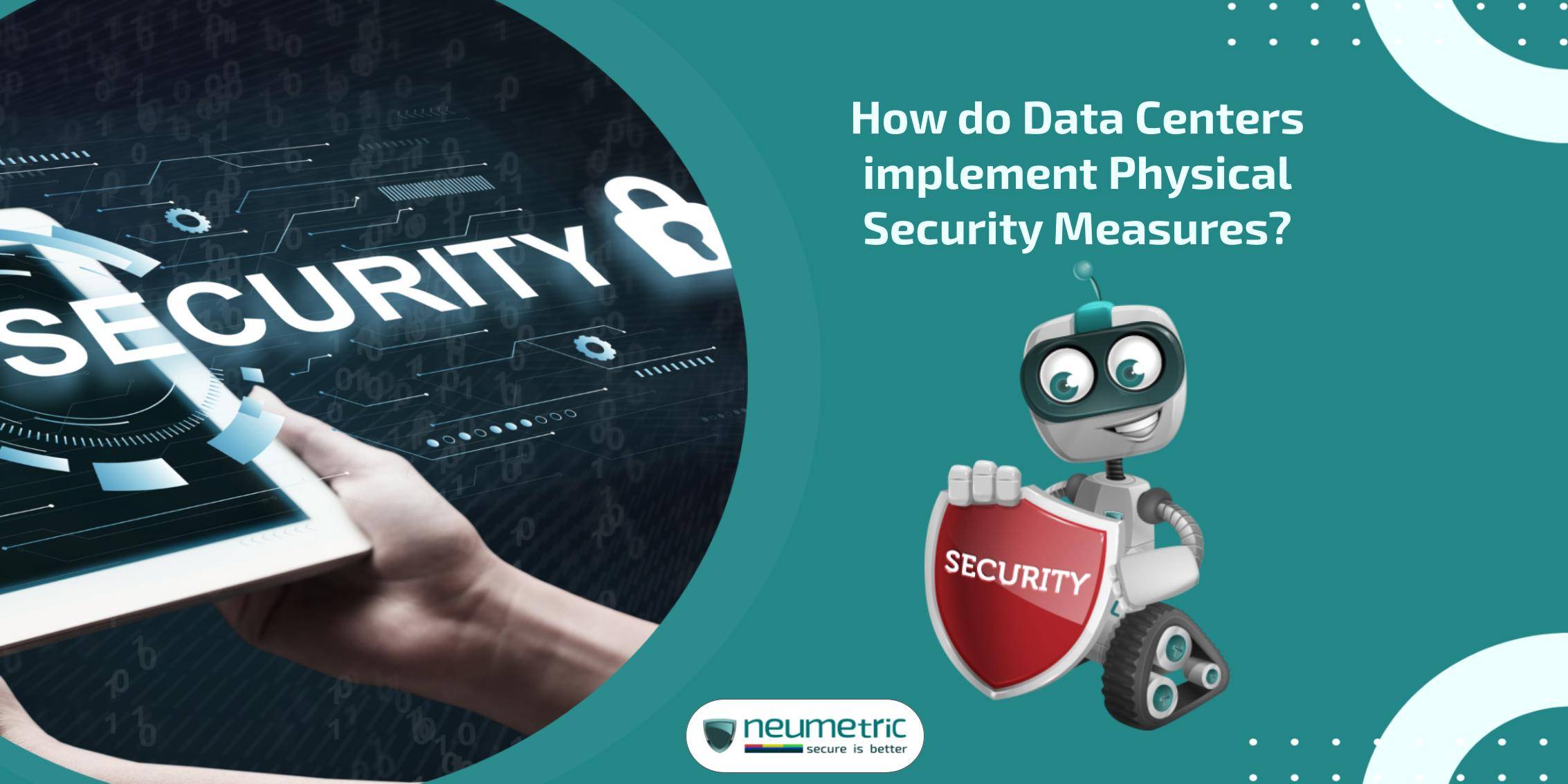Table of Contents
ToggleHow Physical Security Measures for data centers are implemented?
Introduction
In the wide & linked world of data management, physical security in data centres serves as an impenetrable fortress, protecting the digital age’s lifeblood. As technology advances, so does the threat landscape, which aims to exploit weaknesses in these data centres. This Journal aims to shed light on the complexities of physical security in data centres, namely the layers of protection that reinforce these technological bastions.
At the heart of every data centre is a wealth of information—intellectual capital, sensitive data & proprietary algorithms that drive businesses & shape industries. Physical security plays a key role in protecting this precious asset. Beyond firewalls & encryption algorithms, the physical security measures implemented in data centres form the first line of defence against unauthorised access, theft & other tangible threats.
The threat landscape in the digital realm is not static; it evolves with each technological stride forward. The adversaries seeking to breach data centre security are not only numerous but also increasingly sophisticated. Cybercriminals, state-sponsored entities & malicious insiders pose multifaceted threats that necessitate a comprehensive & dynamic approach to physical security. Understanding the ever-changing nature of these threats is crucial for data centres to stay one step ahead in the ongoing cybersecurity arms race.
The goal of this Journal is to peel back the layers of physical security used in data centres, demonstrating the complexities of the methods required to protect against both physical & cyber threats. The Journal’s goal is to provide insights into the holistic tactics used to establish a strong defence mechanism by investigating the symbiotic relationship between physical & cybersecurity. From the planned placement of security perimeters to the integration of cutting-edge technologies, we’ll look at the deliberate architecture that protects the modern world’s digital nerve centres.
Importance of Physical Security Measures for Data Centers
Data is more than just information; it is the lifeblood of organisations. Data has tremendous worth, ranging from secret formulas that drive company strategy to sensitive client information. Physical security measures become critical in protecting this data from unauthorised access, loss or damage, hence ensuring the continuity & integrity of digital processes.
The security scenario for data centres is not restricted to virtual exploits; it also extends into the physical world. Threats range from unauthorised persons getting physical access to key infrastructure to intentional attacks intended to disrupt operations. Recognising the complex nature of these threats is critical for creating a comprehensive security strategy that tackles both cyber & physical vulnerabilities.
The nexus between physical & cybersecurity forms the linchpin of effective data centre protection. A breach in physical security can pave the way for cyber threats & vice versa. The interconnectedness of these realms necessitates an integrated approach where physical security measures complement cybersecurity protocols. Understanding this symbiotic relationship allows data centres to create a unified defence strategy that mitigates risks comprehensively.
Perimeter Security
Site Selection & Layout
Geographic considerations: Strategic site selection is the foundation of effective data centre security. Geographic factors are critical in evaluating the resilience of the data centre to natural catastrophes, geopolitical concerns & other external threats. Data centres are frequently carefully placed, taking into account seismic activity, flood danger & proximity to key infrastructure. A detailed research of the geographical landscape enables the installation of data centres in areas with low environmental concerns, assuring the facility’s longevity & continuous operation.
Optimal Site Layouts for Enhanced Security: Beyond geographic considerations, the layout of the data centre site is a critical component of perimeter security. Optimal site layouts involve careful planning to minimise vulnerabilities & enhance security. This includes considerations such as the placement of entry points, vehicle access routes & the overall configuration of the facility. A well-designed site layout incorporates natural barriers, such as hills or bodies of water, to enhance security & limit access points, reducing the potential for unauthorised intrusion.
Fencing & Barriers
High-Security Fencing: The physical barrier that surrounds a data centre is often the first line of defence against unauthorised access. High-security fencing serves as a deterrent & impediment to intruders, making it an essential component of perimeter security. These fences are typically constructed with materials designed to resist cutting or climbing & may include additional features such as anti-scaling measures & Intrusion Detection Systems [IDS]. The height & structural integrity of high-security fencing contribute to the overall effectiveness of the physical boundary.
Anti-Ram Barriers: In addition to high-security fencing, anti-ram barriers are used to deter potential automobile threats. These barriers are built to resist the impact of a vehicle attempting to cross the perimeter. These obstacles, which take the form of bollards, reinforced gates or other anti-ram systems, are strategically placed to prevent unauthorised vehicles from ramming into the data centre. The combination of high-security fences & anti-ram barriers comprise a powerful physical defence layer, protecting the data centre from both intentional & incidental breaches.
Access Control Systems
Biometric Access
Biometric access control systems use unique physiological traits to verify identities, with fingerprint recognition being the most extensively used method. Fingerprint recognition is a secure & efficient method of giving authorised workers entry in data centres, where access must be closely regulated. Each person’s fingerprint is unique & the system compares the current fingerprint to previously saved templates to grant or deny access. This biometric technique improves security by eliminating the need for traditional keys or access cards, which lowers the danger of unauthorised entry.
Retina scans represent another advanced biometric access control measure. By analysing the unique patterns of blood vessels in the retina, this technology ensures an exceptionally high level of accuracy in identity verification. Data centres employing retina scans for access control enhance security by incorporating a non-intrusive, fast & highly reliable biometric solution. The complexity of retina patterns makes it extremely difficult for unauthorised individuals to replicate, providing an additional layer of protection against unauthorised access.
Card-Based Access Control
Card-based access control systems, which use Radio-Frequency Identification [RFID] technology, provide a flexible & scalable method for managing access in a data centre. Each authorised individual receives an RFID card with a unique identifier. When given to a card reader, RFID technology verifies the user’s identity & grants access to certain regions based on predefined permissions. RFID cards are simply programmed, allowing administrators to change access levels quickly & efficiently. This flexibility is especially useful in dynamic data centre environments where access requirements can change often.
Smart card systems elevate access control by integrating additional security features into the card itself. These cards, equipped with embedded microprocessors, can store & process data, enabling Multi Factor Authentication [MFA]. Smart cards often require a Personal Identification Number [PIN] or biometric verification in conjunction with the card for access. The combination of physical possession of the card & additional authentication factors enhances security, making smart card systems a robust choice for data centres where stringent access controls are imperative.
Surveillance Systems
CCTV Systems
Closed-Circuit Television [CCTV] systems form a critical component of the surveillance infrastructure within data centres. Strategic camera placement is essential to maximise coverage & enhance security. Cameras are strategically positioned to cover key entry points, critical infrastructure areas & other sensitive zones. The goal is to eliminate blind spots & ensure comprehensive monitoring of the facility. This strategic placement not only acts as a deterrent but also provides valuable visual data for real-time monitoring & post-incident analysis.
The effectiveness of CCTV systems relies on the quality of imaging they provide. High-resolution cameras capture intricate details, allowing security personnel to identify individuals, track movements & investigate incidents with precision. In data centres, where the stakes are high, high-resolution imaging is imperative for accurate threat detection. Advanced cameras equipped with features like zoom capabilities further enhance the ability to scrutinise specific areas in real-time or during forensic analysis.
Video Analytics
Video analytics backed by artificial intelligence adds another layer of intelligence to surveillance systems. Intrusion detection systems analyse video feeds in real time to detect unusual activity or unauthorised individuals in restricted areas. This proactive strategy allows security teams to respond quickly to possible security breaches, preventing unauthorised access before it becomes widespread.
Beyond intrusion detection, video analytics may detect trends & anomalies in human behaviour. Unusual activities, such as lingering in restricted areas or attempting to tamper with equipment, generate alarms requiring rapid attention. Behaviour analysis provides a dynamic component to surveillance, enabling a more nuanced & adaptive reaction to possible threats.
Security Personnel
Security Guards: Security guards form the human presence on the front lines of physical security. Their roles encompass a spectrum of responsibilities, including monitoring CCTV feeds, conducting regular patrols & responding to security incidents. They serve as a visible deterrent, deterring potential intruders & providing a rapid response in case of any security breach. Additionally, security guards play a vital role in access control, verifying the identity of individuals & ensuring compliance with security protocols.
Security Operations Center [SOC]
The Security Operations Center [SOC] serves as the nerve centre for monitoring & responding to security events. Staffed 24/7, the SOC oversees the entire surveillance infrastructure, including CCTV systems & video analytics. Security analysts in the SOC monitor live feeds, analyse alerts & coordinate responses to potential threats. The continuous monitoring ensures a proactive stance, allowing for immediate intervention in the event of security incidents.
The SOC operates based on meticulously crafted incident response protocols. These protocols define the steps to be taken in the event of a security incident, including communication procedures, coordination with on-site security personnel & engagement with law enforcement if necessary. Incident response protocols are designed to be agile, allowing for rapid decision-making & execution to minimise the impact of security breaches.
Environmental Controls
Climate Control Systems
Data centres include sensitive electrical equipment that is vulnerable to environmental factors. Climate control systems maintain ideal temperature & humidity levels, preventing overheating & condensation, which could jeopardise equipment performance & longevity. Maintaining a stable & controlled environment is critical for the proper operation of servers & other gear.
Climate control systems sometimes include redundancies to improve reliability. Redundant Heating, Ventilation & Air Conditioning [HVAC] systems & environmental monitoring ensure that even if one system fails, another is in place to keep conditions optimal. This redundancy improves the overall robustness of the data centre’s infrastructure.
Fire Suppression Systems
Fire suppression systems are a critical component of data centre safety. Various types of fire suppression agents, such as clean agents (e.g., FM-200 or Novec 1230) & inert gases (e.g., nitrogen or argon), are deployed based on the specific requirements of the data centre. These agents are designed to quickly extinguish fires without causing damage to the electronic equipment.
While the major purpose of fire suppression is to extinguish fires quickly, minimising damage to equipment is also critical. Fire suppression systems are designed & deployed to protect valuable hardware. Suppressing a fire quickly is critical to preventing the spread of damage & the suppression agent & system design are selected to achieve a compromise between safety & equipment preservation.
Data Center Layout & Design
The layout & design of a data centre play a pivotal role in ensuring the security & resilience of the facility. Secure equipment placement involves strategic positioning of servers, storage units & networking hardware. Redundancy in equipment placement ensures that if one unit fails, there is a backup ready to take over seamlessly. This approach enhances data centre resilience, preventing single points of failure & ensuring continuous operation.
The layout design aims to minimise vulnerabilities & points of access for potential threats. Critical infrastructure is often placed in secure rooms or enclosures with restricted access. Careful consideration is given to the arrangement of aisles, cable management & equipment racks to prevent unauthorised individuals from gaining physical access to sensitive areas. The overall design is a blend of security, efficiency & scalability.
Security Zones
Data centres typically employ controlled access areas to restrict entry to authorised personnel only. These areas house critical infrastructure, networking equipment & servers. Access control measures, including biometric authentication & card-based systems, are implemented to ensure that only authorised individuals can enter these controlled zones. This approach adds an additional layer of security to protect the most sensitive components of the data centre.
Within the data centre layout, certain zones are designated as high-security areas housing critical infrastructure. These areas often include network operation centres, server rooms & storage facilities. Access to these high-security zones is restricted to a select group of personnel with specific clearance levels. Security measures within these zones are heightened, incorporating advanced access controls, surveillance & additional layers of physical security.
Physical Security Audits & Testing
Internal audits form an integral part of maintaining & enhancing physical security in data centres. These audits are conducted by an organisation’s internal security teams to assess adherence to established security policies & procedures. Internal audits evaluate the effectiveness of security controls, the implementation of access control measures & overall compliance with security protocols. Regular internal audits provide insights into potential vulnerabilities, enabling organisations to address issues promptly & continuously improve their security posture.
Complementing internal audits, third-party audits bring an external perspective to the evaluation of physical security measures. Independent security firms or regulatory bodies may conduct third-party audits to assess a data centre’s adherence to industry standards & best practices. These audits often involve a comprehensive review of security protocols, surveillance systems, access controls & environmental controls. Third-party audits offer an unbiased assessment, validating the efficacy of security measures & providing an objective view of the data centre’s security readiness.
Penetration testing, commonly known as ethical hacking, involves simulating real-world cyber & physical attacks to identify vulnerabilities in a data centre’s defences. Physical penetration testing specifically assesses the effectiveness of physical security measures. Skilled professionals attempt to breach the data centre’s security using methods that a malicious actor might employ. This could include attempting unauthorised entry, circumventing access controls or exploiting weaknesses in surveillance systems. The goal is to uncover vulnerabilities before they can be exploited by actual attackers.
Conclusion
A complete summary of the levels of physical security for data centers addressed in this Journal demonstrates the varied approach used to secure data centres. From strategic site selection & perimeter security to advanced surveillance systems, access restrictions & environmental safeguards, each step adds to a comprehensive defence plan. Security professionals, thorough audits & continual testing help to ensure that the physical security structure stays resilient & adaptable.
The data centre security landscape is always changing due to technical breakthroughs, increasing threats & changing regulatory requirements. The conclusion emphasises the importance of data centres adapting on a continuous basis, adopting advances in physical security solutions & maintaining current industry best practices. The continual growth of data centre security is a journey, needing a proactive & adaptable approach to combat the ever-changing threat landscape.
In light of an uncertain future, the conclusion emphasises the significance of developing resilience. Data centres must not only respond to current dangers, but also foresee & prepare for future issues. This includes creating a culture of continuous improvement, investing in training & awareness programmes & refining security strategies based on audit & testing data. By fostering resilience, data centres position themselves to endure the test of time in an age where the only constant is change.
FAQ’s
Why is physical security crucial for data centres?
Physical security is essential to safeguard data centres against unauthorised access, theft & potential physical threats, ensuring the integrity & continuity of operations.
What role do surveillance systems play in data centre security?
Surveillance systems, including CCTV & video analytics, provide real-time monitoring & proactive threat detection, enhancing overall security by identifying & responding to potential breaches.
What is the purpose of penetration testing in data centre security?
Penetration testing simulates real-world attacks to identify vulnerabilities, allowing data centres to address weaknesses & enhance overall security against potential threats.





